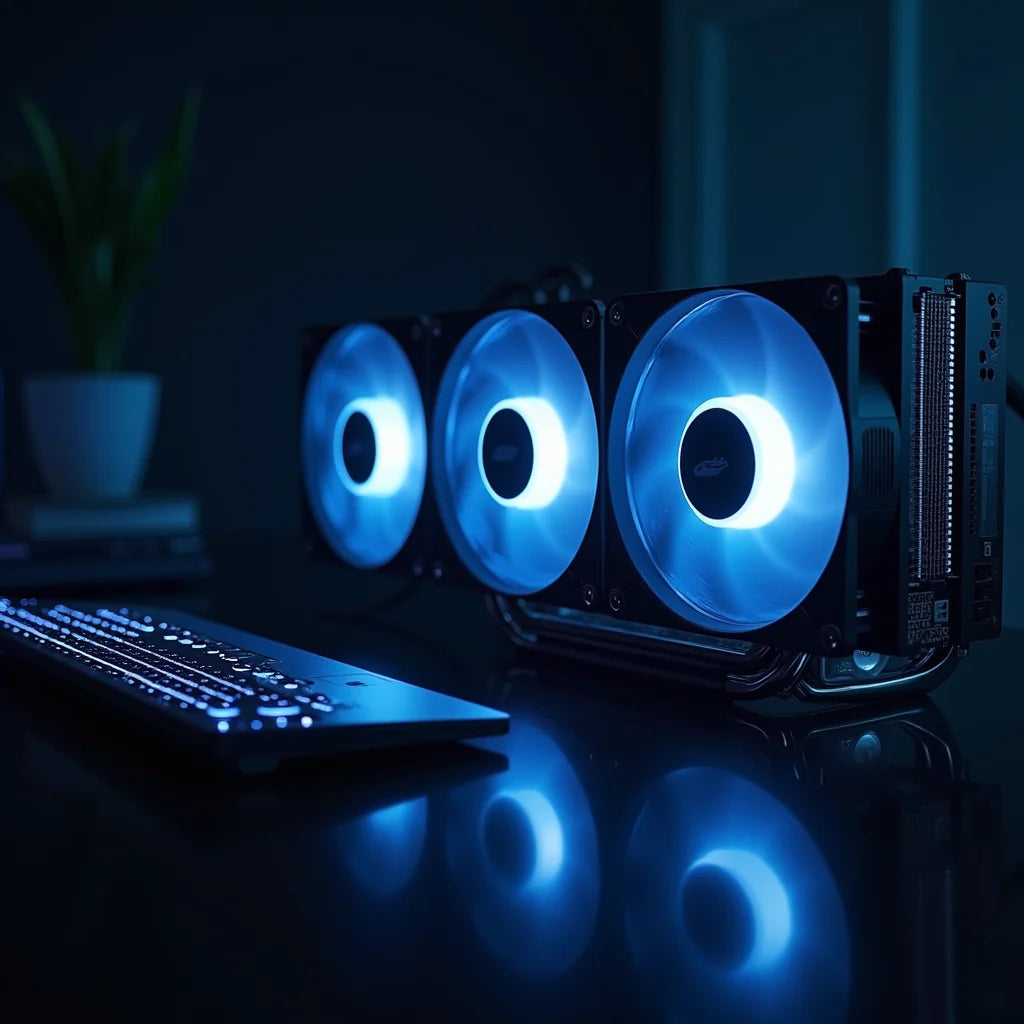
Liquid Cooling Systems Demystified for Quiet, Cool PCs
Nova Electronics Nova ElectronicsShare
Updated on: 2025-11-01
Table of Contents for Liquid Cooling Systems
- Table of Contents for Liquid Cooling Systems
- Liquid Cooling Systems Overview for Performance and Longevity
- Product Spotlight: AIO Liquid Coolers for Modern Builds
- Did You Know? Quick Facts About Liquid Cooling Systems
- Pros and Cons Analysis of Liquid Cooling Solutions
- FAQ: Liquid Cooling Systems and Best Practices
- Conclusion and Next Steps for Liquid Cooling Systems
- About the Author: Expertise in Liquid Cooling Systems
Liquid Cooling Systems Overview for Performance and Longevity
Liquid cooling systems move heat away from CPUs and GPUs more efficiently than traditional air coolers, resulting in lower temperatures, quieter operation, and increased headroom for sustained performance. These liquid cooling solutions are widely adopted by enthusiasts seeking the best liquid cooling systems for gaming PCs and by professionals running thermally demanding workloads. When designed and installed correctly, water cooling systems stabilize clock speeds, extend component lifespan by minimizing thermal cycling, and reduce acoustic output under load.
How Liquid Cooling Solutions Work
Liquid cooling solutions use a closed or open loop to circulate coolant over a heat source, absorb heat through a water block, and release it via a radiator. A pump drives the coolant, while fans exhaust the warmed air from the radiator. Because water has a higher specific heat capacity than air, liquid can move more energy with less noise at a given thermal load. This characteristic is why liquid cooling systems often outperform comparable air coolers at similar noise levels.
Key Components of Water Cooling Systems
- Water block: A copper or nickel-plated cold plate that transfers heat from the chip to the coolant.
- Radiator: A finned heat exchanger that dissipates heat as fans push or pull air through.
- Pump: Circulates coolant through the loop at a controlled flow rate.
- Reservoir (custom loops): Simplifies filling, bleeding, and monitoring coolant levels.
- Tubing and fittings: Connect components and maintain a secure, leak-resistant loop.
- Coolant: Typically a premix with corrosion inhibitors and biocides to protect the loop.
In consumer systems, AIO liquid coolers integrate the pump, tubing, and radiator for ease of installation. In advanced builds, custom loop water cooling allows full control over component selection and loop routing.
Product Spotlight: AIO Liquid Coolers for Modern Builds
AIO liquid coolers offer reliable performance and clean aesthetics with minimal maintenance. They come pre-filled and sealed, which simplifies setup and reduces the potential for user error. For most gaming and creator systems, a quality 240 mm or 360 mm AIO provides strong performance-to-noise efficiency while keeping installation straightforward. Explore compatible options in our AIO coolers lineup to match thermal demand and case clearance.
AIO Versus Custom Loop Water Cooling
Both approaches fall under liquid cooling systems, but the choice depends on goals. AIOs are cost-effective, compact, and generally maintenance-light. Custom loop water cooling offers maximum performance and visual customization with the option to cool multiple components, such as the CPU and GPU in one loop. However, custom loops require planning, assembly, and ongoing care.
Radiator Sizing and Case Fit
Match radiator length and thickness to your case and workload. A 240 mm radiator suits mainstream CPUs and moderate overclocks. A 280 mm or 360 mm radiator supports higher heat loads and quieter fan curves. Check front, top, and side mounting locations to ensure adequate clearance for radiator thickness and fan depth. If your case supports multiple radiator positions, front mounting can offer slightly lower CPU temperatures, while top mounting often improves overall case airflow.
Did You Know? Quick Facts About Liquid Cooling Systems
- Placing radiator fans in push-pull can improve thermal performance at lower RPMs, reducing noise.
- Modern pumps use PWM control, allowing fine-tuned flow rates that balance noise and cooling capacity.
- Thermal paste quality and spread pattern on the CPU heat spreader can influence several degrees of temperature.
- High-density radiators benefit from higher static pressure fans rather than high airflow case fans.
- Coolant chemistry matters: corrosion inhibitors protect mixed-metal loops in custom builds.
Pros and Cons Analysis of Liquid Cooling Solutions
AIO Liquid Coolers: Pros and Cons
- Pros:
- Simple installation with pre-filled, sealed loops.
- Strong performance-to-noise ratio for compact systems.
- Lower maintenance versus custom loops.
- Wide case compatibility across 240 mm and 360 mm sizes.
- Cons:
- Limited customization and upgrade paths.
- Fixed tube length can constrain radiator placement.
- Pump is not serviceable; eventual wear requires replacement.
Custom Loop Water Cooling: Pros and Cons
- Pros:
- Maximum thermal capacity with larger radiators and tailored flow paths.
- Ability to cool CPU, GPU, and even VRM or memory in a single loop.
- Premium aesthetics with hardline tubing and addressable lighting.
- Cons:
- Higher initial cost and longer build time.
- Regular maintenance, including coolant changes and loop inspections.
- Planning complexity around fittings, clearances, and component compatibility.
If you want the best liquid cooling systems for gaming PCs with minimal oversight, an AIO is typically sufficient. If you plan heavy overclocks, multi-GPU workloads, or workstation-class rendering, a custom loop can deliver lower peak temperatures and quieter sustained operation when designed well.
FAQ: Liquid Cooling Systems and Best Practices
Are liquid cooling systems better than air cooling?
In many performance scenarios, liquid cooling systems provide lower temperatures and reduced noise compared with similarly priced premium air coolers. Radiators offer greater surface area and can dissipate heat more efficiently, especially during sustained workloads. However, premium air coolers remain competitive at moderate thermal loads and can be simpler to install. The best choice depends on case space, performance targets, and tolerance for pump noise.
How often should I change the coolant in a liquid cooling system?
AIO liquid coolers do not require routine coolant changes because they are factory sealed. For custom loop water cooling, many builders refresh coolant approximately every 6 to 12 months, depending on coolant type, loop materials, and operating conditions. Inspect fluid clarity and watch for particulate buildup or algae growth. If you observe discoloration or temperature creep, a flush and refill can restore performance.
Do data centers use liquid cooling systems for high-density servers?
Yes. Data center liquid cooling systems for high-density servers are increasingly common where rack power density and heat output exceed the practical limits of air cooling. Solutions range from direct-to-chip cold plates to rear-door heat exchangers. Liquid enables higher density per rack while maintaining target inlet temperatures and improving energy efficiency.
What is the leak risk with liquid cooling solutions?
Modern AIOs are engineered with crimped or barbed fittings and reinforced tubing to minimize leaks over the product lifespan. The risk is low when installed as instructed. For custom loops, leak risk depends on build quality, fitting torque, and maintenance. Performing a bench leak test with the system powered off and using paper towels at each fitting can help confirm a watertight seal before full operation.
For compatibility checks and build planning, browse our cooling collection. If you need assistance with radiator placement or pump curves, visit the support center for guidance and resources.
Conclusion and Next Steps for Liquid Cooling Systems
Liquid cooling systems deliver measurable gains in thermal performance, acoustic comfort, and stability under sustained loads. AIO liquid coolers suit most gaming and creator builds, balancing value and ease of use. Custom loop water cooling offers the highest performance ceiling and visual customization for experienced builders ready to manage maintenance. Define your thermal targets, evaluate case radiator support, and choose components that align with your goals.
Ready to upgrade? Compare sealed coolers and advanced components in the AIO coolers category, explore broader options in the cooling collection, and keep learning through our blog. If questions arise at any step, the support center can help you finalize a reliable configuration.
About the Author: Expertise in Liquid Cooling Systems
Nova Electronics Nova Electronics
Nova Electronics Nova Electronics builds and curates performance-focused components with an emphasis on thermals, acoustics, and reliability. With hands-on experience across AIO and custom loop configurations, the team delivers practical guidance for enthusiasts and professionals. Thank you for reading—reach out anytime with build questions.
